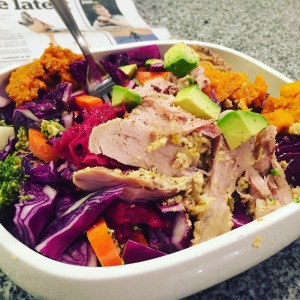After over a year since the Ministry of Health asked for submissions to the draft food guidelines, they have finally announced an update. Undoubtedly they were waiting for the lead taken by the US who are in the process of updating theirs and, looking at ours, it’s a shame that New Zealand didn’t man up and take the lead from Brazil last year, who focused not only on food but non-food related factors related to eating behaviour, such as the eating environment, the social environment and food advertising. Anyway.
As in the first draft, there has been little more than just wordsmithing of the existing guidelines that were last updated in 2003 in this new document, the Eating and Activity Guidelines. While there is a paragraph on the end that recommends choosing ‘whole food’, (which is great, I do really like this), for the most part the guidelines remain largely unchanged from the existing ones and therefore aren’t in line with that recommendation.
While there has been an extended period of time between the original draft and now, and the guidelines say they are based on best available evidence, to my mind this actually is NOT evidence in some areas. As part of the Human Potential Centre we wrote a submission to the Ministry of Health and provided them some of this best available evidence. This hasn’t appeared in the final update. While unsurprising, it is still a bit disappointing.
The full guidelines are here and I just thought I’d give a quick summary of where I feel the Ministry could have improved the guidelines for the health of the population.*
Enjoy a variety of nutritious foods every day including:
- Grain foods, mostly whole grain and those naturally high in fibre
Pasta and noodles and couscous and cereals aren’t whole grains. They may have been whole grain once (as they are grain products!) But they are FAR from whole grain despite what it says on the packet. Sorry. Regardless of whether they say ‘whole grains’ or not, there are few whole grains in the diet. Barley might be one. As Prof Mann from Otago has said ‘most wholegrains in the food supply aren’t intact and are equivalent to a bag of glucose (read this here for a dietitian’s view on the post – and then check out who his clients are or have been….cough cough).
With this in mind, and with two thirds of New Zealander’s categorised as overweight or obese, a growing number of people being diagnosed with pre-diabetes and type 2 diabetes (and many more estimated undiagnosed) it is perplexing that there is a focus on foods which are as nutrient devoid as the packaging they come in (i.e. pasta). Not all carbohydrate sources are created equal, and your naturally occurring carbohydrate sources such as potato, kumara, yams and fruit are far more nutritious sources of carbohydrates for people who can tolerate them. It’s not about ‘no carb’ – it’s about quality carbohydrate. The recommendation to include pasta, cous cous, bread and cereals –processed, refined carbohydrate foods – is in contradiction to the awesome recommendation to choose whole foods.
- Some milk and milk products, mostly low and reduced fat
This is NOT the most up to date research. Many many epidemiological studies support the use of full fat dairy being beneficial for weight management, heart health, gut health in all age groups. Ministry of Health is scared to say ‘blue milk’ as it contains saturated fat (in context of whole food diet in normal amounts, this isn’t an issue.’ MOH should read my blog post on why full fat dairy has important health benefits that can’t be gleaned from low fat. And…. Full fat dairy is far more satiating than low fat. We feel fuller and are able to better manage blood sugar levels and with it mood, concentration and overall energy. We’ve been buying into the low fat message for far too long and it’s about time we kicked that to the curb.
- Some legumes*, nuts, seeds, fish and other seafood, eggs, poultry (eg, chicken) and/or red meat with the fat removed (Eat less than 500 grams of cooked red meat a week.)
A large proportion of New Zealanders are both iron and zinc deficient and red meat is the richest source of these nutrients, along with fat soluble vitamins and antioxidants such as Co-Q10 which play important roles in the health of our cardiovascular, digestive and musculoskeletal systems. Most dietary iron comes from breads and cereals which contain nutrients which bind iron and prevent absorption. There has been the recent IARC report suggesting that red meat is a carcinogen, and while it’s important that red meat intake is moderated to a palm size portion as part of a meal, it’s good to be aware of the critiques around the red meat issue (such as this and this). I do wonder, though, if there are differing health effects in populations eating red meat in places such as New Zealand, where our beef and cattle industry (predominantly grass fed, no antibiotics or hormones) is quite different from the hormone, grain-fed, antibiotic administered environment of that in the US.
In addition – as you know, it’s the processed meat that we need to be more mindful of. Luncheon and saveloys and chargrilled (burnt to a crisp) sausages on the BBQ should be avoided.
- Choose and/or prepare foods and drinks with unsaturated fats instead of saturated fats (SAFA).
We’ve been over this a LOT I know – check this out and this out. Abnormal amounts of anything is going to tip the balance in the wrong direction health wise, especially in the context of a diet that is also high in refined carbohydrate. It can also be problematic for people consuming large amounts in the context of a real food, low carbohydrate diet actually. So it is individual. However there is a difference between consuming ridiculously large amounts (i.e. a bulletproof coffee for breakfast alongside bacon and eggs fried in butter) and encouraging people to choose butter (a minimally processed food) instead of margarine or other industrial seed oil spreads (highly processed) to sauté their green beans in.
In addition, while the guidelines say that it’s beneficial for heart health to replace saturated fat with polyunsaturated (PUFA) fat, I’ve asked some smart people about this and replacing SAFA (or any fat) in the diet with PUFA may only beneficial when the diet is deficient in nutrients such as antioxidants provided by the seed oil, or if the diet is deficient in PUFA (never really seen in New Zealand. Further, the real benefit comes from long chain omega 3 fatty acids (from fish for example) rather than seed oils, which are certainly beneficial for health, including heart, brain and vascular health.
So… while it’s great there is the inclusion of the paragraph that encourages the consumption of real food that is minimally processed (and on that most people are in agreeance), the continual promotion of grain-based foods, low fat dairy and plant-based polyunsaturated fats such as seed oils goes against this recommendation. I don’t know if this paragraph is merely a nod to the growing awareness the consumer is having with regards to their food (rather than a genuine recommendation) or a lack of understanding of what ‘minimally processed’ means. It feels like they have their feet in both camps, but it could only serve to confuse people who are navigating an already confused food environment.
*someone else much smarter and more articulate with more time could probably do a more indepth review.










